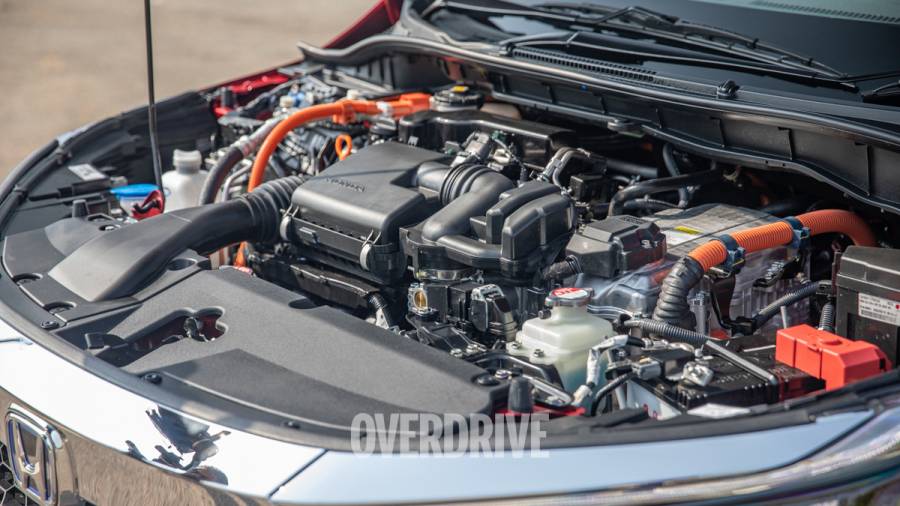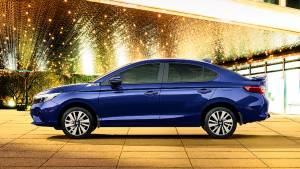2022 Honda City eHEV: Unique hybrid system explained
Turning a few pages back, hybrid technology, as seen in the Honda City e:HEV, is the use of two different sources of power in a single vehicle to provide motive force. The most common combination is an internal combustion engine (petrol or diesel) with an electric motor, both of which work in different ways to move a vehicle. The intent is to ideally use as much of the electric motor as possible thereby reducing carbon emissions, improving fuel efficiency or enhancing performance.

Types of hybrid systems
There are several forms of hybrids: full hybrids, micro-hybrids, or plug-in hybrids. Plug-in hybrids need to be plugged into the electric grid to charge the batteries that run the electric motor. These can run in fully electric mode for long distances. A mild hybrid always works in parallel, which means the engine and electric motor are always working together. A full hybrid can run on either the electric motor alone or the internal combustion engine alone or in combination. The Honda City e:HEV fills the role of a full hybrid and that makes it a fairly interesting proposition for Indian consumers. This is because, without an adequate charging grid, plug-in hybrids aren't as efficient, and mild hybrids' benefits are minuscule, but a full hybrid like the City e:HEV employs brings with it a wide range of benefits without depending on any external factors.

Honda City e:HEV hybrid technology explained
Honda's e:HEV hybrid technology is a fairly complex one, especially since a lot of the numbers we sought to get clarity weren't made available. The benefits however are fairly simple, you get significantly better efficiency, better power delivery and lower emissions. So if end results are your goals, skip this part and move on to our review of the Honda City e:HEV hybrid with its mileage numbers.

The Honda City e:HEV hybrid comprises of these primary parts. A 1.5-litre DOHC I-VTEC petrol engine that runs on the Atkinsons cycle, two electric motors: one for generating traction and the second for power generation, a power control unit that manages the flow, dispensation and storage of electric current between the generator and the battery, and finally the lithium-ion battery. In addition, the Honda City e:HEV also has energy recuperation systems, generated by using the brakes and engine braking.
- The petrol engine has 2 principal functions. The first is to run the car, the second is to charge the battery. Now the latter function is an inefficient function, simply put, using the engine to charge the battery consumes more fuel. This is where the Atkinson cycle it operates on comes into effect. It is a significantly more efficient cycle (almost 16-20% more efficient) than the Otto cycle that most engines run on and is primarily used on hybrids. This reduces the inefficiencies and ensures fewer losses during the battery charging phases.
- The 2 electric motors have two different functions. One is used to provide motive force to the City e:HEV, and the second is to charge the battery. This electric motor is free of heavy rare earth magnets that conventional electric vehicles use. That adds another layer to Honda's quest for sustainable mobility.
- The power control unit manages the power within the system that is used either to charge the batteries during braking or dispensed to the electric motors during acceleration. It has an inverter that powers the motor, a boost converter to increase voltage for the electric motor to operate, and a DCDC converter to lower voltage. During acceleration, it converts DC to AC power that is supplied to the motor, and while braking it converts AC power to DC to charge the Lithium-Ion batteries. It also manages the heat generated in the motors during operations thus enhancing efficiency.
- The lithium-ion batteries, which Honda hasn't shared much about, but what we do know is that these have large storage capacities, enough to run the car for several kilometres on a single charge. They are also quick to recharge and slow to discharge making them highly efficient for The Lithium-ion batteries, which Honda hasn't shared much about, but what we do know from data on the Accord, CR-V, and other hybrids in the Honda fleet is this is a small battery pack, probably the same 1kWh used elsewhere but with enough juice to run the car for several kilometres on a single charge. This battery is also quick to recharge and slow to discharge making it highly efficient for use in the City e:HEV.

Honda City e:HEV hybrid drive modes explained
The Honda City e:HEV works in three driving modes, these cannot be selected by the driver and are automatically engaged depending on the driving conditions.
- The first is the all-electric mode. This usually takes place when you start driving if you accelerate gently and speeds are low. In this mode, the electric motor alone comes into play, and at speeds of up to nearly 40kmph, the electric motor alone can be in operation. The electric motor will also drive the front wheels despite the speeds being high if accelerator inputs are low. For instance, just 10 per cent throttle will still engage only the electric motor even for high-speed cruising. Hard accelerator inputs will however bring the petrol motor into the equation.
- In hybrid mode, where both the electric motor and petrol engine come into play operating in combination. This is usually in effect when you step down on the throttle pedal to generate more power, for example when trying to overtake another vehicle or if you accelerate hard from a standstill. The hybrid mode also gets engaged at low-speed cruising
- In engine only mode, where just the petrol engine is used. This occurs when the speeds increase above a certain limit, from what I observed in the City e:HEV, this felt like it was above 40kmph, though if you read the explanation below you will see why it only comes on as a singular entity during high-speed cruising. Now, the engine is constantly turning, except when it does at low speeds it is powering the generator motor which charges the batteries and deliver power to the driven motor which rotates the countershaft which rotates the differential which rotates the wheels.

Honda City e:HEV hybrid regen mode explained
There is one more mode in the City e:HEV which is deceleration and during this phase, the batteries are recharged. This takes place by one of two ways. You can use the brakes to recharge the batteries, converting kinetic energy into electric energy during braking. Or you can use the selective recuperation mode using the paddle shifts with three levels of energy recuperation. The left paddle increases the level of regeneration, while the right pedal reduces it.
It kind of works like a traditional gear selector, except it does not change the ratios. When engaged, to activate recuperation, all you have to do is release the accelerator pedal and cruise, this creates a kind of dynamo effect that recharges the battery. The braking feel generated during regeneration isn't too aggressive in either of the modes and if timed right it can almost provide you with one-pedal drivability though, unlike in an EV, the City e:HEV does not entirely come to a stop unless you use the brakes.
Also read,
2022 Honda City hybrid e:HEV review, first drive - real-world mileage tested
2022 Honda City hybrid e:HEV launched in India at Rs 19.50 lakh, one ZX variant
2022 Honda City hybrid eHEV production begins in India, launch in May
All upcoming Honda cars to get ADAS features in India
India-spec 2022 Honda City Hybrid eHEV revealed with 26.5 kmpl mileage
Starts Rs 10.9 Lakhs
1497cc
Manual
100
145
17.8 Kmpl
Starts Rs 19.5 Lakhs
1498cc
e-CVT
126
253
26.5 Kmpl
Related Stories
Top Stories
Latest Videos
Most Popular
- Maruti Suzuki Fronx Drive Feature: Switch to Plan B
- Ford India to make a comeback in 2025? New-Gen Endeavour design patented in India
- Maruti Suzuki Brezza emerges as the most successful SUV of 2023
- Nissan Magnite EZ-Shift review - is the AMT any good?
- Hyundai Creta facelift bookings open for token amount of Rs 25,000














